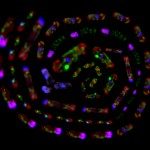Lien vers Pubmed [PMID] – 16489235
Genetics 2006 Apr;172(4):2211-22
The high level of gene redundancy that characterizes eukaryotic genomes results in part from segmental duplications. Spontaneous duplications of large chromosomal segments have been experimentally demonstrated in yeast. However, the dynamics of inheritance of such structures and their eventual fixation in populations remain largely unsolved. We analyzed the stability of a vast panel of large segmental duplications in Saccharomyces cerevisiae (from 41 kb for the smallest to 268 kb for the largest). We monitored the stability of three different types of interchromosomal duplications as well as that of three intrachromosomal direct tandem duplications. In the absence of any selective advantage associated with the presence of the duplication, we show that a duplicated segment internally translocated within a natural chromosome is stably inherited both mitotically and meiotically. By contrast, large duplications carried by a supernumerary chromosome are highly unstable. Duplications translocated into subtelomeric regions are lost at variable rates depending on the location of the insertion sites. Direct tandem duplications are lost by unequal crossing over, both mitotically and meiotically, at a frequency proportional to their sizes. These results show that most of the duplicated structures present an intrinsic level of instability. However, translocation within another chromosome significantly stabilizes a duplicated segment, increasing its chance to get fixed in a population even in the absence of any immediate selective advantage conferred by the duplicated genes.

